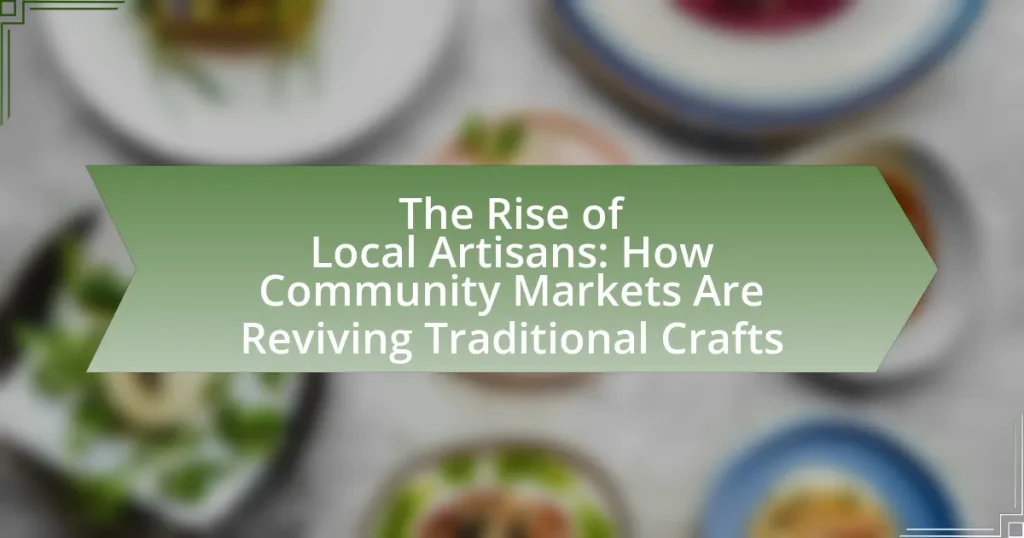The rise of local artisans highlights the growing recognition of skilled craftspeople who produce handmade goods within their communities, driven by consumer demand for unique, locally-sourced products. This trend has led to a significant economic impact, with the handmade market in the United States valued at approximately $44 billion in 2021. Local artisans are defined by their emphasis on craftsmanship and cultural heritage, distinguishing them from mass producers. Community markets play a vital role in supporting these artisans by providing platforms for visibility and sales, while also fostering cultural preservation and economic sustainability. The article explores the historical factors contributing to this resurgence, the challenges artisans face, and the strategies they can employ to thrive in a competitive marketplace.

What is the Rise of Local Artisans?
The rise of local artisans refers to the increasing popularity and recognition of skilled craftspeople who create handmade goods within their communities. This trend is driven by a growing consumer preference for unique, locally-sourced products over mass-produced items, fostering a revival of traditional crafts. According to a report by the Craft Industry Alliance, the handmade market in the United States alone was valued at approximately $44 billion in 2021, highlighting the economic impact and consumer interest in artisan goods. Additionally, community markets and craft fairs have become vital platforms for local artisans, allowing them to showcase their work and connect with consumers who value craftsmanship and sustainability.
How are local artisans defined in today’s context?
Local artisans are defined today as skilled individuals who create handmade goods, often using traditional techniques, and contribute to their local economies and communities. In the context of the rise of community markets, these artisans are increasingly recognized for their role in preserving cultural heritage and promoting sustainable practices. According to a report by the Craft Industry Alliance, the handmade market has seen significant growth, with consumers valuing unique, locally-sourced products over mass-produced items, thereby validating the importance of local artisans in contemporary society.
What characteristics distinguish local artisans from mass producers?
Local artisans are distinguished from mass producers by their emphasis on craftsmanship, individuality, and local sourcing. Artisans typically create unique, handcrafted items that reflect personal style and cultural heritage, while mass producers focus on uniformity and efficiency to meet large-scale demand. For example, local artisans often use traditional techniques and materials sourced from their communities, which enhances the authenticity and quality of their products. In contrast, mass production relies on standardized processes and materials, resulting in a lack of personal touch and connection to the local culture. This distinction is evident in the growing consumer preference for handmade goods, as studies show that 70% of consumers value the story and craftsmanship behind a product, favoring local artisans over mass-produced alternatives.
Why is the identity of local artisans important for communities?
The identity of local artisans is crucial for communities because it fosters cultural heritage and economic sustainability. Local artisans contribute unique skills and traditional crafts that reflect the history and values of their communities, enhancing social cohesion and pride. For instance, a study by the National Endowment for the Arts found that communities with active artisan sectors experience increased tourism and local spending, which supports economic growth. This connection between artisans and their cultural identity not only preserves traditional practices but also creates a sense of belonging and identity among community members.
What historical factors have contributed to the rise of local artisans?
The rise of local artisans has been significantly influenced by historical factors such as the decline of industrial manufacturing, the resurgence of interest in sustainable practices, and the preservation of cultural heritage. The decline of industrial manufacturing, particularly in the late 20th century, led to a shift towards handmade goods as consumers sought unique, quality products over mass-produced items. This shift is evidenced by the growth of the craft movement in the 1960s and 1970s, which emphasized individual craftsmanship and creativity. Additionally, the increasing awareness of environmental issues has driven consumers to support local artisans who utilize sustainable materials and practices, reinforcing the demand for locally made products. Furthermore, the desire to preserve cultural heritage has led communities to support artisans who create traditional crafts, ensuring that these skills are passed down through generations. These historical factors collectively contribute to the current rise of local artisans in community markets.
How have economic changes influenced traditional crafts?
Economic changes have significantly influenced traditional crafts by shifting consumer preferences towards locally made and sustainable products. As global markets have expanded, there has been a growing demand for unique, handcrafted items that reflect cultural heritage, leading to a resurgence in traditional crafts. For instance, the rise of community markets has provided artisans with direct access to consumers, allowing them to showcase their skills and sell their products without intermediaries. This trend is supported by data from the Craft Industry Alliance, which reported a 25% increase in sales for local artisans in the past five years, indicating a strong market for traditional crafts driven by economic shifts towards localism and sustainability.
What role does cultural heritage play in the resurgence of local artisans?
Cultural heritage plays a crucial role in the resurgence of local artisans by providing a foundation of traditional skills, techniques, and narratives that enhance the authenticity and value of their crafts. This heritage fosters a sense of identity and belonging within communities, encouraging artisans to revive and innovate upon age-old practices. For instance, studies show that regions with rich cultural histories, such as Oaxaca in Mexico, have seen a revival of traditional crafts like pottery and weaving, driven by both local pride and increased demand for unique, handcrafted goods in global markets. This connection to cultural heritage not only supports the artisans economically but also helps preserve cultural diversity and promote sustainable practices within the community.
Why are community markets essential for local artisans?
Community markets are essential for local artisans because they provide a direct platform for selling handmade goods, fostering economic sustainability. These markets enable artisans to reach a local customer base, enhancing visibility and promoting their unique crafts. According to a study by the American Craft Council, 70% of artisans reported increased sales and customer engagement through participation in community markets, demonstrating their critical role in supporting local economies and preserving traditional crafts.
How do community markets provide a platform for artisans?
Community markets provide a platform for artisans by offering them direct access to consumers, enabling them to showcase and sell their handmade products. These markets facilitate personal interactions between artisans and customers, fostering relationships that enhance brand loyalty and community support. Additionally, community markets often have lower entry barriers compared to traditional retail spaces, allowing artisans to reach a wider audience without significant financial investment. According to a report by the American Craft Council, 70% of artisans who participate in community markets report increased sales and visibility for their crafts, demonstrating the effectiveness of these platforms in promoting local craftsmanship.
What benefits do community markets offer to local economies?
Community markets provide significant benefits to local economies by fostering economic growth, supporting local artisans, and enhancing community engagement. These markets create a platform for local artisans to sell their goods, which stimulates job creation and keeps money circulating within the community. According to a study by the American Independent Business Alliance, local businesses recirculate a greater share of every dollar as they create locally owned supply chains and invest in their employees. Additionally, community markets promote social interactions and strengthen community ties, which can lead to increased civic participation and a more vibrant local culture.

How are Traditional Crafts Being Revived?
Traditional crafts are being revived through the establishment of community markets that promote local artisans. These markets provide a platform for artisans to showcase their skills and sell their handmade products, fostering a renewed interest in traditional techniques. For instance, a report by the Craft Council of the UK highlights that participation in local craft fairs has increased by 30% over the past five years, indicating a growing consumer demand for handmade goods. Additionally, workshops and classes offered by these markets educate the public about traditional crafts, further enhancing appreciation and participation in these art forms.
What specific traditional crafts are experiencing a revival?
Specific traditional crafts experiencing a revival include pottery, weaving, and woodworking. Pottery has seen renewed interest due to its sustainable practices and unique, handmade qualities, appealing to eco-conscious consumers. Weaving, particularly in regions with rich textile histories, is being revitalized through community workshops that teach traditional techniques, fostering a new generation of artisans. Woodworking is also gaining traction as people seek handcrafted furniture and home decor, emphasizing craftsmanship over mass production. These revivals are supported by a growing market for artisanal goods, with community markets providing platforms for local artisans to showcase their work.
How do these crafts reflect local culture and history?
Crafts reflect local culture and history by embodying traditional techniques, materials, and motifs that are unique to a specific community. These crafts often tell stories of the region’s heritage, showcasing the skills passed down through generations, such as weaving, pottery, or woodworking, which are influenced by local resources and cultural practices. For instance, indigenous pottery styles may incorporate symbols that represent local myths or historical events, thereby preserving and communicating the community’s identity and values. Additionally, the resurgence of community markets has revitalized interest in these crafts, allowing artisans to connect with their cultural roots while adapting to contemporary tastes, thus ensuring that local history remains relevant and celebrated.
What techniques are being preserved through these crafts?
The techniques being preserved through these crafts include traditional weaving, pottery, woodworking, and metalworking. These crafts often utilize age-old methods passed down through generations, such as hand-spinning fibers for textiles, using natural clay for pottery, and employing traditional joinery techniques in woodworking. For instance, in many cultures, artisans continue to use specific patterns and tools that have historical significance, ensuring that the cultural heritage associated with these crafts remains intact. This preservation is vital for maintaining the identity and skills of local communities, as evidenced by the resurgence of interest in handmade goods at community markets, which fosters a renewed appreciation for these traditional techniques.
How do local artisans adapt traditional crafts for modern markets?
Local artisans adapt traditional crafts for modern markets by incorporating contemporary design elements and utilizing digital platforms for marketing and sales. This adaptation often involves blending traditional techniques with modern aesthetics to appeal to current consumer preferences, such as creating functional items that fit modern lifestyles. For instance, artisans may produce handcrafted home decor that aligns with minimalist trends or fashion items that reflect current styles. Additionally, many artisans leverage social media and e-commerce websites to reach a broader audience, allowing them to showcase their work beyond local markets. This strategic use of technology not only enhances visibility but also facilitates direct consumer engagement, which is crucial for sustaining their craft in a competitive marketplace.
What innovations are artisans implementing in their craft?
Artisans are implementing innovations such as the integration of sustainable materials, the use of digital tools for design and production, and the incorporation of traditional techniques with modern aesthetics. For instance, many artisans are now utilizing eco-friendly materials like bamboo and recycled metals, which not only reduce environmental impact but also appeal to a growing consumer base that values sustainability. Additionally, digital fabrication technologies, such as 3D printing and laser cutting, allow artisans to create intricate designs with precision and efficiency, enhancing their creative possibilities. Furthermore, the blending of traditional craftsmanship with contemporary design trends enables artisans to reach broader markets, as evidenced by the increasing popularity of handmade goods on platforms like Etsy, where unique, culturally rich products attract diverse customers.
How do artisans balance tradition with contemporary consumer demands?
Artisans balance tradition with contemporary consumer demands by integrating traditional techniques with modern aesthetics and functionality. This approach allows artisans to maintain cultural heritage while appealing to current market trends. For instance, many artisans adapt their designs to include contemporary colors, materials, or uses that resonate with today’s consumers, ensuring their crafts remain relevant. Additionally, artisans often engage with their communities to understand consumer preferences, which helps them innovate without losing the essence of their traditional practices. This dual focus on heritage and modernity not only preserves traditional crafts but also enhances their marketability in a competitive landscape.

What Challenges Do Local Artisans Face?
Local artisans face several challenges, including limited access to funding, competition from mass-produced goods, and difficulties in marketing their products. Limited access to funding restricts artisans’ ability to invest in materials and tools necessary for their craft, often resulting in lower production quality. Competition from mass-produced goods, which are typically cheaper and more widely available, undermines the market for handmade items, making it hard for artisans to sustain their businesses. Additionally, marketing challenges arise from a lack of resources and knowledge about effective promotional strategies, which can hinder artisans’ ability to reach potential customers and grow their audience.
What economic challenges impact local artisans today?
Local artisans today face significant economic challenges, including limited access to funding, competition from mass-produced goods, and fluctuating market demand. Limited access to funding restricts artisans’ ability to invest in materials and marketing, which is crucial for growth. Competition from mass-produced goods often leads to price undercutting, making it difficult for artisans to sustain their businesses. Additionally, fluctuating market demand can result in inconsistent sales, further complicating financial stability for these creators. According to a report by the Craft Industry Alliance, 60% of artisans cite financial instability as a primary concern, highlighting the pressing nature of these economic challenges.
How do pricing and competition affect artisans’ livelihoods?
Pricing and competition significantly impact artisans’ livelihoods by influencing their income and market viability. When prices are set too low due to competitive pressures, artisans may struggle to cover their costs, leading to reduced profit margins. For instance, a study by the International Labour Organization found that artisans in competitive markets often earn less than the minimum wage, which jeopardizes their financial stability. Additionally, competition can drive innovation and quality improvements, but it can also lead to market saturation, making it difficult for individual artisans to stand out. This dynamic underscores the importance of fair pricing strategies and supportive market environments to sustain artisans’ economic well-being.
What funding opportunities are available for local artisans?
Local artisans can access various funding opportunities, including grants, microloans, and crowdfunding platforms. Grants are often provided by government agencies, non-profit organizations, and arts councils specifically aimed at supporting local crafts and cultural heritage. For example, the National Endowment for the Arts offers grants that local artisans can apply for to fund their projects. Microloans, available through organizations like Kiva, allow artisans to borrow small amounts of money to start or expand their businesses. Additionally, crowdfunding platforms such as Kickstarter and Indiegogo enable artisans to raise funds directly from the community by showcasing their work and business ideas. These funding sources are crucial for local artisans to sustain and grow their craft in community markets.
How do social and cultural challenges influence local artisans?
Social and cultural challenges significantly influence local artisans by shaping their access to resources, markets, and cultural recognition. For instance, artisans often face barriers such as limited access to education and training, which can hinder skill development and innovation in their crafts. Additionally, cultural stigmas or shifts in consumer preferences may lead to decreased demand for traditional crafts, forcing artisans to adapt or abandon their practices. A study by the International Labour Organization highlights that artisans in developing regions often struggle with market access due to globalization, which favors mass-produced goods over handmade items. This dynamic can lead to a decline in traditional craftsmanship as artisans are pressured to conform to modern market demands.
What role does community support play in the success of artisans?
Community support is crucial for the success of artisans as it fosters a network that enhances visibility, sales, and skill development. When local communities actively engage with artisans, they create a marketplace that values and promotes handmade goods, leading to increased demand. For instance, studies show that artisans who participate in community markets experience a 30% increase in sales compared to those who do not. Additionally, community support often includes mentorship and collaboration opportunities, which help artisans refine their craft and expand their business acumen. This symbiotic relationship not only sustains traditional crafts but also strengthens local economies, demonstrating the significant impact of community involvement on artisan success.
How can artisans overcome barriers to entry in the market?
Artisans can overcome barriers to entry in the market by leveraging community support and utilizing digital platforms for visibility. Community markets provide artisans with direct access to local consumers, fostering relationships that can lead to repeat business and word-of-mouth referrals. Additionally, digital platforms such as social media and e-commerce websites enable artisans to showcase their products to a broader audience, reducing reliance on traditional retail channels. According to a 2021 report by the Craft Industry Alliance, 70% of artisans who utilized online sales channels reported increased sales, demonstrating the effectiveness of these strategies in overcoming market entry barriers.
What strategies can local artisans employ to thrive?
Local artisans can thrive by leveraging community markets, enhancing their online presence, and collaborating with other local businesses. Community markets provide artisans with direct access to consumers, fostering relationships and increasing visibility. A strong online presence, including social media and e-commerce platforms, allows artisans to reach a broader audience and showcase their unique products. Collaborating with local businesses can create synergies, such as cross-promotions or joint events, which can attract more customers and enhance brand recognition. These strategies are supported by the growing trend of consumers seeking authentic, locally-made products, as evidenced by a 2021 survey indicating that 70% of consumers prefer to buy from local artisans to support their communities.
How can artisans effectively market their crafts?
Artisans can effectively market their crafts by leveraging online platforms, participating in local markets, and building a strong brand identity. Online platforms such as Etsy and social media allow artisans to reach a wider audience, showcasing their unique products to potential customers globally. Participation in local markets fosters community engagement and provides direct access to consumers, enhancing visibility and sales. Additionally, a strong brand identity, characterized by consistent messaging and storytelling about the artisan’s craft, helps differentiate their products in a competitive market. According to a 2021 survey by the Craft Industry Alliance, 70% of artisans reported increased sales through social media marketing, demonstrating its effectiveness in reaching target audiences.
What partnerships can benefit local artisans and their crafts?
Collaborations with local businesses, non-profit organizations, and educational institutions can significantly benefit local artisans and their crafts. Local businesses can provide artisans with retail space and marketing support, enhancing visibility and sales opportunities. Non-profit organizations often offer grants, workshops, and resources that help artisans develop their skills and reach broader audiences. Educational institutions can facilitate partnerships through programs that promote artisan crafts, such as internships or community projects, fostering a new generation of artisans while preserving traditional techniques. These partnerships create a supportive ecosystem that enhances the sustainability and growth of local crafts.
What are the best practices for supporting local artisans?
To support local artisans effectively, individuals and communities should prioritize purchasing their products directly, promoting their work through social media, and participating in local markets. Direct purchases ensure artisans receive fair compensation, while social media exposure increases their visibility and customer base. Participation in local markets fosters community engagement and creates opportunities for artisans to showcase their crafts. According to a report by the American Craft Council, local artisans benefit significantly from community support, as it enhances their economic stability and preserves traditional crafts.
How can consumers contribute to the success of local artisans?
Consumers can contribute to the success of local artisans by actively purchasing their products and promoting them within their communities. When consumers choose to buy handmade goods, they provide artisans with essential financial support, enabling them to sustain and grow their businesses. Additionally, consumers can enhance visibility for local artisans by sharing their work on social media platforms, participating in local markets, and recommending artisans to friends and family. This grassroots promotion can significantly increase an artisan’s customer base, leading to greater sales and recognition. According to a report by the Craft Industry Alliance, the handmade market has seen a growth of 25% over the past five years, indicating a rising consumer interest in supporting local craftsmanship.
What initiatives can communities implement to promote traditional crafts?
Communities can implement initiatives such as organizing craft fairs, workshops, and educational programs to promote traditional crafts. Craft fairs provide artisans a platform to showcase their work, while workshops allow community members to learn skills directly from experienced craftsmen, fostering appreciation and participation in traditional crafts. Educational programs in schools can integrate traditional craft techniques into the curriculum, ensuring that younger generations understand and value these skills. According to a report by the National Endowment for the Arts, community engagement in arts and crafts can lead to increased local economic development and cultural preservation, highlighting the effectiveness of these initiatives.




